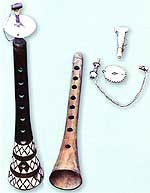|
Zurna
N.Rahmanov.
Devachi,2000
|
The
zurna, an instrument with a strong, high tone, is
widespread in Azerbaijan.
It
occupies an important place in Azerbaijan's cultural
life. The name "zurna" is thought to have
come from the word "surnay", translated
as "sur" (a large banquet) and "nay"
(cane or reed). Many types of zurna were widespread
in the Middle East and Caucasus. Four types of zurna
made of deer horn were found during the archeological
excavations at one of the ancient settlements in Mingachevir.
According to researchers, these instruments date back
3,000 years.9
The
zurna is used mainly during national holidays for
performing folk music in the open air. There were
at least six types of zurna: "gara zurna"
(black zurna), "gaba zurna", "arabi
zurna" (Arabian zurna), "jura zurna"
(small zurna), "ajami zurna" (zurna of ajams)
and "shahabi zurna".
The
zurna is usually made of apricot, walnut or mulberry
wood. The diameter at the top of the instrument is
20 mm; at the lower part of the instrument, it is
60 mm. The length of the zurna is 302-317 mm. There
are seven apertures on the front side of the instrument.
| |
 |
Zurna
The
State Museum
of Azerbaijani
Musical Culture
|
The
end of the instrument has a plug ("masha")
that is 120 mm long. It is made of wild willow, walnut
or apricot wood. The purpose of the plug is to regulate
the tuning of the instrument.. The mouthpiece is 7-10
mm long and made of cane. The player produces sound
from the instrument by inhaling air and breathing
it out through the mouthpiece.
A round bobbin is attached to the round board in the
middle of the pivot. The bobbin functions as a kind
of support for the lips. The air passes through the
mouthpiece, pivot and plug and enters into the body
of the instrument. The player plays the zurna by opening
and closing the apertures with his fingers.
The
range of the zurna goes from the "ti" flat
of the small octave to the "do" of the third
octave. Depending on the mastery of the performer,
the range can be expanded by a few notes. These keys
are identified as "extra" keys.
As
a rule, the zurna is included in wind instrument ensembles.
As a solo instrument, or in ensembles or orchestras,
the zurna is used for performing some dance melodies
such as the "jangi" and other musical patterns.
Uzeyir Hajibeyov included the zurna in the symphonic
orchestra for his opera "Koroghlu".
|